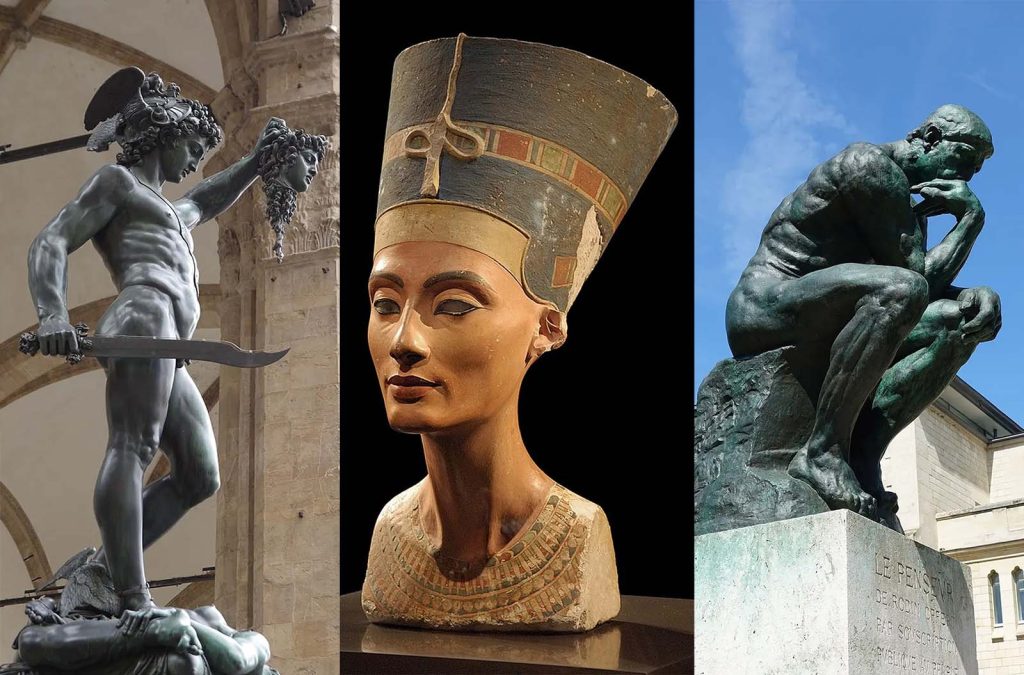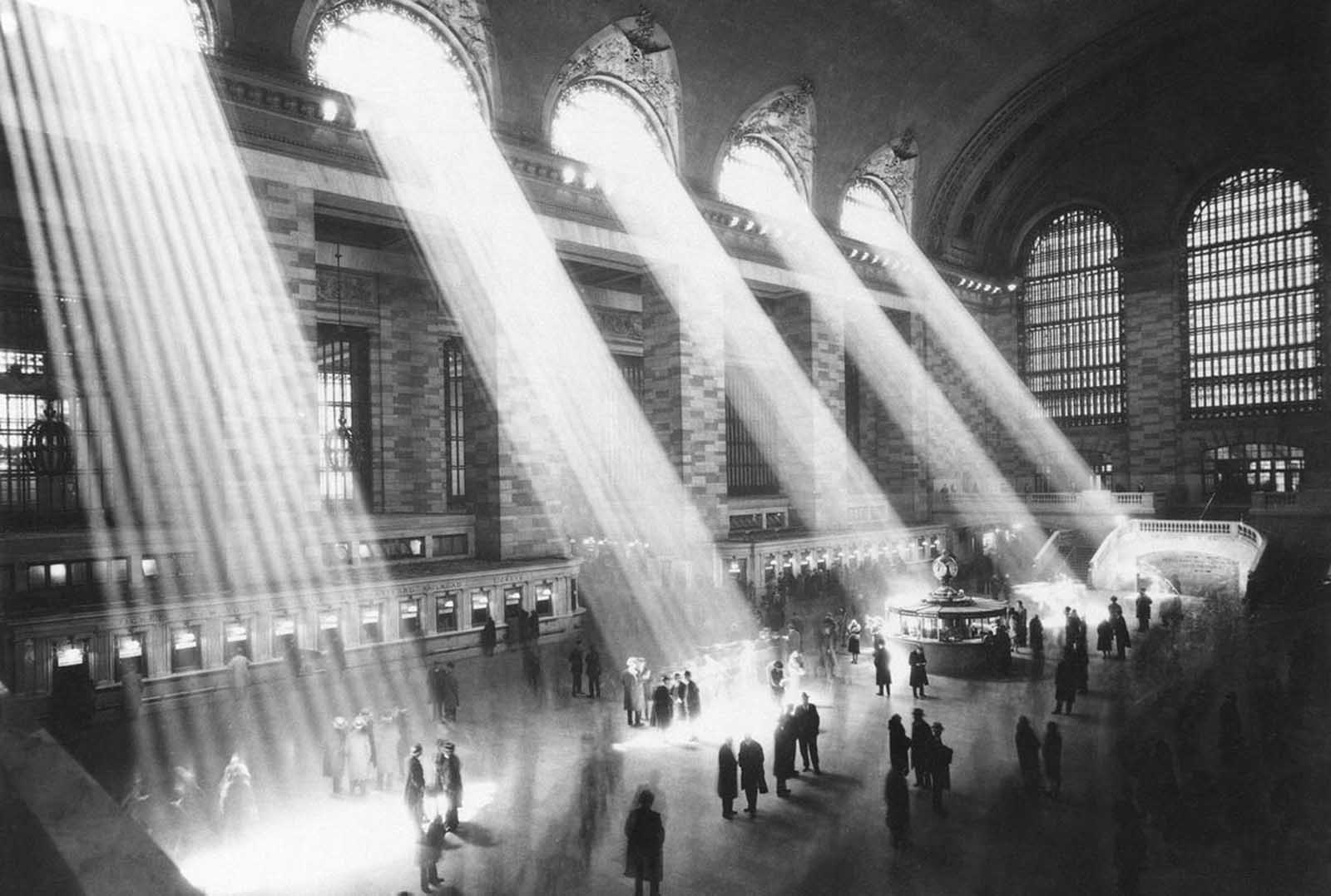Sculptures are one of the oldest visual art forms in existence and one of the most publicly visible forms of artwork. It has been around for thousands of years, and it’s an art that can be created in a variety of materials, such as stone, wood, bronze, and more.
From our earliest times, sculpture has been an important way to understand culture and society, whether from portrait busts of great leaders or symbolic renderings of ethical principles.
Historically, sculpture has been defined against, and typically in direct opposition to, painting, largely because sculpture breaks the constraints of the canvas and embraces the possibilities of the third dimension. It occupies a space in a manner that is impossible to the very nature of painting.
The architectural foundations of sculpture, both literal and figurative, continued into both the Greek and Roman conceptions of this medium. Sculpture was tied to temples, public buildings, and monuments.
Two significant changes should, however, be noted. Whereas Egyptian sculpture existed primarily in relief form, Greek and Roman sculpture, the latter of which was mainly inspired in the replication and restoration of Greek sculpture began to experiment with freestanding figures, as, for instance, in the statue of Aphrodite of Melos.
Furthermore, whereas sculpture has previously been considered merely decorative in nature, it now began to take on a stronger significance as the representation of the gods.
In this collection, we will take a look at famous sculptures throughout history to show the variety of art that has captured the public’s imagination. Groundbreaking, beautiful, and often thought-provoking, these works have withstood the test of time.
Venus of Willendorf (28,000–25,000 BC)
The Venus of Willendorf is an 11.1-centimeter-tall (4.4 in) Venus figurine estimated to have been made around 25,000–30,000 years ago.
It was found on August 7, 1908, by a workman named Johann Veran or Josef Veram during excavations conducted by archaeologists Josef Szombathy, Hugo Obermaier, and Josef Bayer at a Paleolithic site near Willendorf, a village in Lower Austria.
It is carved from an oolitic limestone that is not local to the area, and tinted with red ochre. The figurine is now in the Natural History Museum in Vienna, Austria.

The purpose of the carving is the subject of much speculation. Like other similar sculptures, it probably never had feet, and would not have stood on its own, although it might have been pegged into soft ground.
Parts of the body associated with fertility and childbearing have been emphasized, leading some researchers to believe that the Venus of Willendorf and similar figurines may have been used as fertility goddess.
The figure has no visible face, her head being covered with circular horizontal bands of what might be rows of plaited hair, or perhaps a type of headdress.
Nefertiti Bust (1345 BCE)
The Nefertiti Bust is a painted stucco-coated limestone bust of Nefertiti, the Great Royal Wife of Egyptian pharaoh Akhenaten. The work is believed to have been crafted in 1345 BCE by Thutmose because it was found in his workshop in Amarna, Egypt.
It is one of the most-copied works of ancient Egypt. Nefertiti has become one of the most famous women of the ancient world and an icon of feminine beauty.

A German archaeological team led by Ludwig Borchardt discovered the bust in 1912 in Thutmose’s workshop. It has been kept at various locations in Germany since its discovery, including the cellar of a bank, a salt-mine in Merkers-Kieselbach, the Dahlem museum, the Egyptian Museum in Charlottenburg and the Altes Museum.
It is currently on display at the Neues Museum in Berlin, where it was originally displayed before World War II.
The bust is 48 centimeters (19 in) tall and weighs about 20 kilograms (44 lb). It is made of a limestone core covered with painted stucco layers.
The face is completely symmetrical and almost intact, but the left eye lacks the inlay present in the right. The pupil of the right eye is of inserted quartz with black paint and is fixed with beeswax.

The ears have suffered some damage. Gardner’s Art Through the Ages suggests that “With this elegant bust, Thutmose may have been alluding to a heavy flower on its slender sleek stalk by exaggerating the weight of the crowned head and the length of the almost serpentine neck.”
According to David Silverman, the bust reflects the classical Egyptian art style, deviating from the “eccentricities” of the Amarna art style, which was developed in Akhenaten’s reign.
The exact function of the bust is unknown, though it is theorized that the bust may be a sculptor’s modello to be used as a basis for other official portraits, kept in the artist’s workshop.
Great Sphinx of Giza (2500 BC)
The Great Sphinx of Giza is a limestone statue of a reclining sphinx, a mythical creature with the head of a human, and the body of a lion.
Facing directly from west to east, it stands on the Giza Plateau on the west bank of the Nile in Giza, Egypt. The face of the Sphinx appears to represent the pharaoh Khafre.

Its nose was broken off for two possible reasons. The first reason is that the nose was shot by Napoleon Bonaparte during a French invasion of Egypt using a cannonball in the 18th century.
There has been further evidence disapproving of this because there were paintings of the Sphinx with its broken nose in the 17th century, before Napoleon was even born.
The second reason is that in 1378 CE, a religious rebel by the name of Mohamed Sa’m al-Dahr was responsible for destroying the nose who was later executed for vandalism. Of course, the nose could have been simply damaged by weather and corrosion.
The Sphinx is the oldest known monumental sculpture in Egypt and one of the most recognizable statues in the world. The archaeological evidence suggests that it was created by ancient Egyptians of the Old Kingdom during the reign of Khafre (c. 2558–2532 BC).
Terracotta Army (late 3rd century BCE)
The Terracotta Army is a collection of terracotta sculptures depicting the armies of Qin Shi Huang, the first emperor of China. It is a form of funerary art buried with the emperor in 210–209 BCE with the purpose of protecting the emperor in his afterlife.
The figures, dating from approximately the late third century BCE, were discovered in 1974 by local farmers in Lintong County, outside Xi’an, Shaanxi, China.
The figures vary in height according to their roles, the tallest being the generals. The figures include warriors, chariots, and horses.

Estimates from 2007 were that the three pits containing the Terracotta Army held more than 8,000 soldiers, 130 chariots with 520 horses, and 150 cavalry horses, the majority of which remained buried in the pits near Qin Shi Huang’s mausoleum. Other terracotta non-military figures were found in other pits, including officials, acrobats, strongmen, and musicians.
The terracotta figures are life-sized, typically ranging from 175 cm (5.74 ft) to about 200 cm (6.6 ft) (the officers are typically taller). They vary in height, uniform, and hairstyle in accordance with rank.
Their faces appear to be different for each individual figure; scholars, however, have identified 10 basic face shapes. The figures are of these general types: armored infantry; unarmored infantry; cavalrymen who wear a pillbox hats.
Others: helmeted drivers of chariots with more armor protection; spear-carrying charioteers; kneeling crossbowmen or archers who are armored; standing archers who are not; as well as generals and other lower-ranking officers.

Other colors including pink, lilac, red, white, and one unidentified color. The colored lacquer finish and individual facial features would have given the figures a realistic feel, with eyebrows and facial hair in black and the faces done in pink.
The Discus Thrower (460-450 BC)
The Discobolus of Myron is an Ancient Greek sculpture completed at the start of the Classical period at around 460–450 BC. The sculpture depicts a youthful male athlete throwing a discus.
The bronze Greek original is lost. The work is known through its numerous Roman copies, both full-scale ones in marble, which is cheaper than bronze, such as the first to be recovered, the Palombara Discobolus, and smaller scaled versions in bronze.

He has taken a moment of action so transitory that students of athletics still debate if it is feasible, and he has given it the completeness of a cameo.”
The moment thus captured in the statue is an example of rhythmos, harmony and balance. Myron is often credited with being the first sculptor to master this style.
Laocoön and His Sons (c. 323 BCE – 31 CE)
The statue of Laocoön and His Sons has been one of the most famous ancient sculptures ever since it was excavated in Rome in 1506 and placed on public display in the Vatican Museums, where it remains.
It is very likely the same statue that was praised in the highest terms by the main Roman writer on art, Pliny the Elder.
The figures are near life-size and the group is a little over 2 m (6 ft 7 in) in height, showing the Trojan priest Laocoön and his sons Antiphantes and Thymbraeus being attacked by sea serpents.

The suffering is shown through the contorted expressions of the faces (Dr. Guillaume-Benjamin Duchenne pointed out to Charles Darwin that Laocoön’s bulging eyebrows are physiologically impossible), which are matched by the struggling bodies, especially that of Laocoön himself, with every part of his body straining.
Winged Victory of Samothrace (c.190 BCE)
The Winged Victory of Samothrace, or the Nike of Samothrace, is a votive monument originally found on the island of Samothrace, north of the Aegean Sea.
It is a masterpiece of Greek sculpture from the Hellenistic era, dating from the beginning of the 2nd century BC.
It is composed of a statue representing the goddess Niké (Victory), whose head and arms are missing, and its base in the shape of a ship’s bow.

The sculpture is one of a small number of major Hellenistic statues surviving in the original, rather than Roman copies. Winged Victory has been exhibited at the Louvre Museum in Paris, at the top of the main staircase, since 1884.
Venus de Milo (130 BCE)
The Venus de Milo is an ancient Greek sculpture that was created during the Hellenistic period, sometime between 150 and 125 BC.
It is one of the most famous works of ancient Greek sculpture, having been prominently displayed at the Louvre Museum since shortly after the statue was rediscovered on the island of Milos, Greece, in 1820.

The sculpture is sometimes called the Aphrodite de Milos, due to the imprecision of naming the Greek sculpture after a Roman deity (Venus).
Some scholars theorize that the statue actually represents the sea-goddess Amphitrite, who was venerated on the island in which the statue was found.
Made of Parian marble, the statue is larger than life size, standing 204 cm (6 ft 8 in) high. The statue is missing both arms, with part of one arm, as well as the original plinth, being lost after the statue’s rediscovery.
David by Donatello (1430-1440)
Almost 100 years before Michelangelo’s David, Italian Renaissance sculptor Donatello created an iconic version of the Biblical tale.
Cast in bronze, Donatello’s David is younger and more contemplative, having just slain Goliath. In fact, Donatello cleverly uses Goliath’s head and David’s sword as supports for the structure.

The statue’s physique, contrasted with the large sword in hand, shows that David has overcome Goliath not by physical prowess, but through God.
The young men’s nakedness further implies the idea of the presence of God, contrasting the youth with the heavily-armored giant. David is presented uncircumcised, which is customary for male nudes in Italian Renaissance art.
David by Michelangelo (1501-1504)
David is a masterpiece of Renaissance sculpture, created in marble between 1501 and 1504 by the Italian artist Michelangelo.
David is a 5.17-meter (17 ft 0 in) marble statue of the Biblical figure David, a favored subject in the art of Florence.

The statue was moved to the Galleria dell’Accademia, Florence, in 1873, and later replaced at the original location by a replica.
Because of the nature of the figure it represented, the statue soon came to symbolize the defence of civil liberties embodied in the Republic of Florence, an independent city-state threatened on all sides by more powerful rival states and by the hegemony of the Medici family.
The eyes of David, with a warning glare, were fixated towards Rome where the Medici family lived.
The Rape of Proserpina by Gian Lorenzo Bernini (1621-1622)
The Rape of Proserpina, more accurately translated as the Abduction of Proserpina, is a large Baroque marble group sculpture by Italian artist Gian Lorenzo Bernini, executed between 1621 and 1622, when Bernini’s career was in its early stage.
The group, finished when Bernini was just 23 years old, depicts the abduction of Proserpina, who is seized and taken to the underworld by the god Pluto.

It features a Pluto holding a Proserpina aloft, and a Cerberus to symbolize the border into the underworld that Pluto carries Proserpina into.
Bernini drew heavy inspiration from Giambologna and Annibale Carracci for the sculpture, which is also the only work for which preparatory material survives.
The Rape of Proserpina is made of rare Carrara marble and was originally placed on a since-destroyed pedestal with a poem by Maffeo Barberini.
It has been praised for its realism, as the marble mimics other materials like flesh. The detail is notable; for instance, a trickle of tears contributes expressiveness of Proserpina’s face.
Pietà (1498-1499)
The Madonna della Pietà informally known as La Pietà is a Roman Catholic dolorous image of Jesus and Mary at Mount Golgotha representing the “Sixth Sorrow” of the Blessed Virgin Mary and a key work of Italian Renaissance sculpture carved by Michelangelo Buonarroti, now enshrined within Saint Peter’s Basilica, Vatican City.
It is the first of a number of works of the same subject by the Florentine artist.

The figures are quite out of proportion, owing to the difficulty of depicting a fully-grown man cradled full-length in a woman’s lap.
Much of Mary’s body is concealed by her monumental drapery, and the relationship of the figures appears quite natural.
Michelangelo’s interpretation of the Pietà was far different from those previously created by other artists, as he sculpted a young and beautiful Mary rather than a naturally older woman (aged 45) that should be commensurate with the natural age of her son, Jesus (aged 33).
Perseus with the Head of Medusa(1545–1554)
Perseus with the Head of Medusa is a bronze sculpture made by Benvenuto Cellini in the period 1545–1554.
The sculpture stands on a square base that has bronze relief panels depicting the story of Perseus and Andromeda, similar to a predella on an altarpiece.

Perseus stands naked except for a sash and winged sandals, triumphant on top of the body of Medusa with her head, crowned with writhing snakes, in his raised hand. Blood spews from Medusa’s severed neck.
The bronze sculpture, in which Medusa’s head turns men to stone, is appropriately surrounded by three huge marble statues of men: Hercules, David, and later Neptune.
Cellini’s use of bronze in Perseus and the head of Medusa, and the motifs he used to respond to the previous sculpture in the piazza, were highly innovative.
Examining the sculpture from the back, one can see a self-portrait of the sculptor Cellini on the back of Perseus’ helmet.
Ecstasy of Saint Teresa by Gian Lorenzo Bernini (1647–1652)
The Ecstasy of Saint Teresa is a sculptural group in white marble set in an elevated aedicule in the Cornaro Chapel of the church of Santa Maria della Vittoria in Rome.

It is generally considered to be one of the sculptural masterpieces of the High Roman Baroque. The sculpture depicts Teresa of Ávila, a Spanish Carmelite nun and saint, swooning in a state of religious ecstasy, while an angel holding a spear stands over her.
Statue of Liberty (1876-1886)
The Statue of Liberty is a colossal neoclassical sculpture on Liberty Island in New York Harbor in New York City, in the United States.
The copper statue, a gift from the people of France, was designed by French sculptor Frédéric Auguste Bartholdi and its metal framework was built by Gustave Eiffel . The statue was dedicated on October 28, 1886.

The statue is a figure of Libertas, a robed Roman liberty goddess. She holds a torch above her head with her right hand, and in her left hand carries a tabula ansata inscribed JULY IV MDCCLXXVI (July 4, 1776 in Roman numerals), the date of the U.S. Declaration of Independence.
A broken shackle and chain lie at her feet as she walks forward, commemorating the recent national abolition of slavery.
After its dedication, the statue became an icon of freedom and of the United States, seen as a symbol of welcome to immigrants arriving by sea.
The Thinker by Rodin
The Thinker is a bronze sculpture by Auguste Rodin, usually placed on a stone pedestal. The work depicts a nude male figure of heroic size sitting on a rock.
He is seen leaning over, his right elbow placed on his left thigh, holding the weight of his chin on the back of his right hand.
The pose is one of deep thought and contemplation, and the statue is often used as an image to represent philosophy.

There are also 27 other known full-sized castings, in which the figure is approximately 185 cm (73 inches) high, although not all were made during Rodin’s lifetime and under his supervision.
There are various other versions, several in plaster, and studies and posthumous castings exist in a range of sizes.
Unique Forms of Continuity in Space by Umberto Boccioni (1913-1931)
Unique Forms of Continuity in Space is a 1913 bronze Futurist sculpture by Umberto Boccioni. It is seen as an expression of movement and fluidity.
The sculpture is depicted on the obverse of the Italian-issue 20-cent euro coin. The sculpture depicts a human-like figure apparently in motion.

The sculpture has an aerodynamic and fluid form. As a pedestal, two blocks at the feet connect the figure to the ground.
The figure is also armless and without a discernibly real face. The form was originally inspired by the sight of a football player moving on to a perfectly weighted pass.
Fountain by Duchamp (1917)
Fountain is a readymade sculpture by Marcel Duchamp in 1917, consisting of a porcelain urinal signed “R. Mutt”. In April 1917, an ordinary piece of plumbing chosen by Duchamp was submitted for an exhibition of the Society of Independent Artists, the inaugural exhibition by the Society to be staged at the Grand Central Palace in New York.

When explaining the purpose of his readymade sculpture, Duchamp stated they are “everyday objects raised to the dignity of a work of art by the artist’s act of choice.”
In Duchamp’s presentation, the urinal’s orientation was altered from its usual positioning. Fountain was not rejected by the committee, since Society rules stated that all works would be accepted from artists who paid the fee, but the work was never placed in the show area.
Following that removal, Fountain was photographed at Alfred Stieglitz’s studio, and the photo published in the Dada journal The Blind Man. The original has been lost.
Lincoln Memorial (1920)
Abraham Lincoln (1920) is a colossal seated figure of the 16th President of the United States Abraham Lincoln (1809–1865) sculpted by Daniel Chester French (1850–1931) and carved by the Piccirilli Brothers.
It is in the Lincoln Memorial (constructed 1914–1922), on the National Mall, Washington, D.C., United States, and was unveiled in 1922. The work follows in the Beaux Arts and American Renaissance style traditions.

The figure of Lincoln gazes directly ahead and slightly down with an expression of gravity and solemnity. His frock coat is unbuttoned, and a large United States flag is draped over the chair back and sides.
French paid special attention to Lincoln’s expressive hands, which rest on the enormous arms of a semi-circular ceremonial chair, the fronts of which bear fasces, emblems of authority from Roman antiquity. French used casts of his own fingers to achieve the correct placement.
Monument to Yuri Gagarin (1980)
Monument to Yuri Gagarin is a 42.5-meter high pedestal and statue of Yuri Gagarin, the first person to travel in space. It is located at Leninsky Prospekt in Moscow.
The pedestal is designed to be reminiscent of a rocket exhaust. The statue is made of titanium, a metal often used in spacecraft, and weighs 12 tons.

The inscription at the base of the monument reads (in Russian): On April 12, 1961, the Soviet space ship Vostok with a man on board flew around the globe. The first person to penetrate into space is a citizen of the Union of Soviet Socialist Republics, Yuri Gagarin.
Manneken Pis (1619)
Manneken Pis is a landmark 55.5 cm (21.9 in) bronze fountain sculpture in central Brussels, Belgium, depicting a puer mingens; a naked little boy urinating into the fountain’s basin.
Though its existence is attested as early as the 15th century, it was designed in its current form by the Brabantine sculptor Jérôme Duquesnoy the Elder and put in place in 1618 or 1619.

Nowadays, it is one of the best-known symbols of Brussels and Belgium, inspiring many imitations and similar statues. The figure is regularly dressed up and its wardrobe consists of around one thousand different costumes.
Due to its self-derisive nature, it is also an example of belgitude , as well as of folk humor ( zwanze ) popular in Brussels.
Maman by Louise Bourgeois (1999)
Maman (1999) is a bronze, stainless steel, and marble sculpture by the artist Louise Bourgeois. The sculpture, which depicts a spider, is among the world’s largest, measuring over 30 ft high and over 33 ft wide (927 x 891 x 1024 cm).
It includes a sac containing 32 marble eggs and its abdomen and thorax are made of ribbed bronze.

The sculpture picks up the theme of the arachnid that Bourgeois had first contemplated in a small ink and charcoal drawing in 1947, continuing with her 1996 sculpture Spider.
It alludes to the strength of Bourgeois’ mother, with metaphors of spinning, weaving, nurture, and protection.
Her mother, Josephine, was a woman who repaired tapestries in her father’s textile restoration workshop in Paris. When Bourgeois was twenty-one, she lost her mother to an unknown illness.
Cloud Gate by Anish Kapoor (2004)
Cloud Gate is a public sculpture by Indian-born British artist Anish Kapoor, that is the centerpiece of AT&T Plaza at Millennium Park in the Loop community area of Chicago, Illinois.
Made up of 168 stainless steel plates welded together, its highly polished exterior has no visible seams. It measures 33 by 66 by 42 feet (10 by 20 by 13 m), and weighs 110 short tons (100 t; 98 long tons).

On the underside is the “omphalos” (Greek for “navel”), a concave chamber that warps and multiplies reflections.
The sculpture builds upon many of Kapoor’s artistic themes, and it is popular with tourists as a photo-taking opportunity for its unique reflective properties.
(Photo credit: Wikimedia Commons / Wikipedia / Britannia / MOMA).



